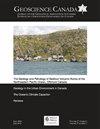The Canadian Federation of Earth Sciences Scientific Statement on Climate Change – Its Impacts in Canada, and the Critical Role of Earth Scientists in Mitigation and Adaptation
IF 0.8
4区 地球科学
Q3 GEOSCIENCES, MULTIDISCIPLINARY
引用次数: 0
Abstract
The Canadian Federation of Earth Sciences (CFES) has issued this statement to summarize the science, effects, and implications of climate change. We highlight the role of Earth scientists in documenting and mitigating climate change, and in managing and adapting to its consequences in Canada. CFES is the coordinated voice of Canada’s Earth Sciences community with 14 member organizations representing some 15,000 geoscientists. Our members are drawn from academia, industry, education, and government. The mission of CFES is to ensure decision makers and the public understand the contributions of Earth Science to Canadian society and the economy. Climate change has become a national and global priority for all levels of government. The geological record shows us that the global climate has changed throughout Earth’s history, but the current rates of change are almost unprecedented. Over the last 70 years, levels of common greenhouse gases (GHGs) in the atmosphere have steadily increased. Carbon dioxide (CO2) concentration is now 418 parts per million — its highest of the last three million years. The chemical (isotopic) composition of carbon in the atmosphere indicates the increase in GHGs is due to burning fossil fuels. GHGs absorb energy emitted from Earth’s surface and re-radiate it back, warming the lower levels of the atmosphere. Climatic adjustments that have recently occurred are, in practical terms, irreversible, but further change can be mitigated by lowering emissions of GHGs. Climate change is amplified by three important Earth system processes and effects. First, as the climate warms evaporation increases, raising atmospheric concentrations of water vapour, itself a GHG — and adding to warming. Second, loss of ice cover from the polar ice sheets and glaciers exposes larger areas of land and open water — leading to greater absorption of heat from the sun. Third, thawing of near-surface permafrost releases additional GHGs (primarily CO2 and methane) during decay of organic matter previously preserved frozen in the ground. Some impacts of climate change are incremental and steadily occurring, such as melting of glaciers and ice sheets, with consequent sea level rise. Others are intermittent, such as extreme weather events, like hurricanes — but are becoming more frequent. Summer water shortages are increasingly common in western Canada as mountain snowpacks melt earlier and summer river flows decline. In northern Canada, warming and thawing of near-surface permafrost has led to deterioration of infrastructure and increased costs for buildings that now require chilled foundations. Other consequences of unchecked climate change include increased coastal erosion, increases in the number and size of wildfires, and reduction in winter road access to isolated northern communities. Reductions in net GHG emissions are urgently required to mitigate the many effects of further climate change. Industrial and public works development projects must now assess the effects of climate change in their planning, design, and management. Cities, municipalities, and rural communities need to plan new residential development carefully to avoid enhanced risk of flooding, coastal erosion, or wildfire. Earth Science knowledge and expertise is integral to exploration and development of new metals and Earth materials required for a carbon-neutral future, and in the capture and storage of CO2 within the Earth. Earth Science is also central to society’s adaptation to new climatic regimes and reduction of risks. This includes anticipation, assessment, and management of extreme events, development of new standards and guidelines for geotechnical and engineering practice, and revision to regulations that consider climate change. Geoscientists also have an important role in the education of students and the public on the reasons for necessary action. Canada is uniquely positioned with its strong global geoscientific leadership, its vast landmass, and its northern terrain to effectively leverage research activities around climate change. Geoscience tools and geoscientists’ skills will be integral to Canada’s preparation for climate change.加拿大地球科学联合会关于气候变化的科学声明————其对加拿大的影响以及地球科学家在减缓和适应气候变化方面的关键作用
加拿大地球科学联合会(CFES)发表了这份声明,总结了气候变化的科学、影响和影响。我们强调地球科学家在记录和缓解气候变化以及管理和适应加拿大气候变化后果方面的作用。CFES是加拿大地球科学界的协调声音,有14个成员组织,代表约15000名地球科学家。我们的成员来自学术界、工业界、教育界和政府。CFES的使命是确保决策者和公众了解地球科学对加拿大社会和经济的贡献。气候变化已成为各级政府的国家和全球优先事项。地质记录向我们表明,在地球历史上,全球气候发生了变化,但目前的变化速度几乎是前所未有的。在过去的70年里,大气中常见温室气体的水平稳步上升。二氧化碳(CO2)浓度目前为百万分之418,是过去300万年来的最高值。大气中碳的化学(同位素)组成表明,温室气体的增加是由于燃烧化石燃料造成的。温室气体吸收从地球表面释放的能量并将其重新辐射回来,使较低水平的大气层变暖。从实际意义上讲,最近发生的气候调整是不可逆转的,但可以通过降低温室气体排放来缓解进一步的变化。三个重要的地球系统过程和影响放大了气候变化。首先,随着气候变暖,蒸发量增加,增加了大气中的水蒸气浓度,这本身就是一种温室气体,并加剧了气候变暖。其次,极地冰盖和冰川的冰盖消失暴露了更大面积的陆地和开阔水域,从而导致对太阳热量的吸收更大。第三,近地表永久冻土的融化在之前保存在地下的有机物腐烂过程中释放出额外的温室气体(主要是二氧化碳和甲烷)。气候变化的一些影响是渐进和稳定发生的,例如冰川和冰盖的融化,随之而来的是海平面上升。其他是间歇性的,比如飓风等极端天气事件,但越来越频繁。夏季缺水在加拿大西部越来越普遍,因为山区积雪提前融化,夏季河流流量下降。在加拿大北部,近地表永久冻土的变暖和融化导致基础设施恶化,并增加了现在需要冷却地基的建筑成本。不受控制的气候变化的其他后果包括海岸侵蚀加剧,野火的数量和规模增加,以及通往孤立的北部社区的冬季道路减少。迫切需要减少温室气体净排放,以减轻进一步气候变化的许多影响。工业和公共工程发展项目现在必须在规划、设计和管理中评估气候变化的影响。城市、市政当局和农村社区需要仔细规划新的住宅开发,以避免洪水、海岸侵蚀或野火的风险增加。地球科学知识和专业知识对于碳中和的未来所需的新金属和地球材料的勘探和开发以及在地球内捕获和储存二氧化碳是必不可少的。地球科学也是社会适应新气候制度和降低风险的核心。这包括对极端事件的预测、评估和管理,制定岩土工程实践的新标准和指南,以及修订考虑气候变化的法规。地球科学家在教育学生和公众采取必要行动的原因方面也发挥着重要作用。加拿大凭借其强大的全球地球科学领导力、广阔的陆地和北部地形,处于独特的地位,可以有效利用气候变化研究活动。地球科学工具和地球科学家的技能将是加拿大应对气候变化的不可或缺的组成部分。
本文章由计算机程序翻译,如有差异,请以英文原文为准。
求助全文
约1分钟内获得全文
求助全文
来源期刊

Geoscience Canada
地学-地球科学综合
CiteScore
3.30
自引率
0.00%
发文量
9
审稿时长
>12 weeks
期刊介绍:
Established in 1974, Geoscience Canada is the main technical publication of the Geological Association of Canada (GAC). We are a quarterly journal that emphasizes diversity of material, and also the presentation of informative technical articles that can be understood not only by specialist research workers, but by non-specialists in other branches of the Earth Sciences. We aim to be a journal that you want to read, and which will leave you better informed, rather than more confused.
 求助内容:
求助内容: 应助结果提醒方式:
应助结果提醒方式:


